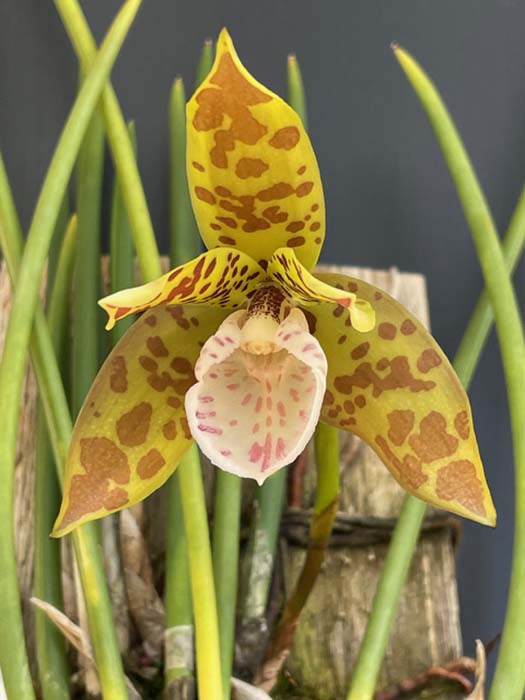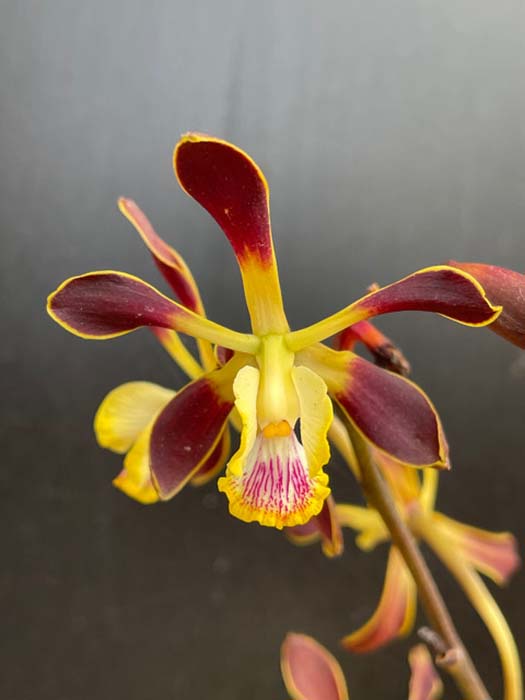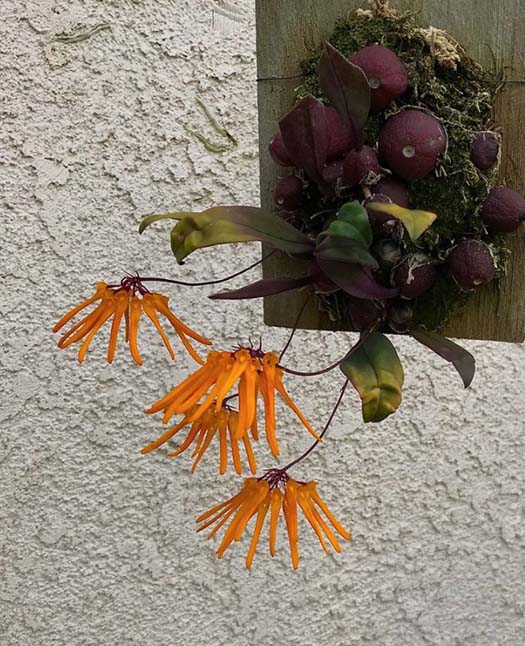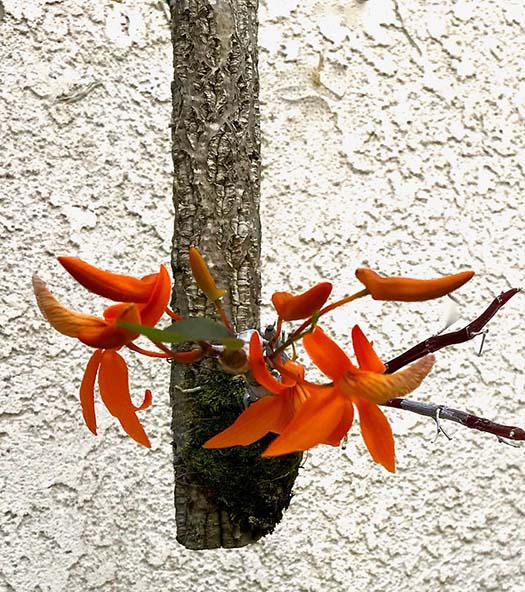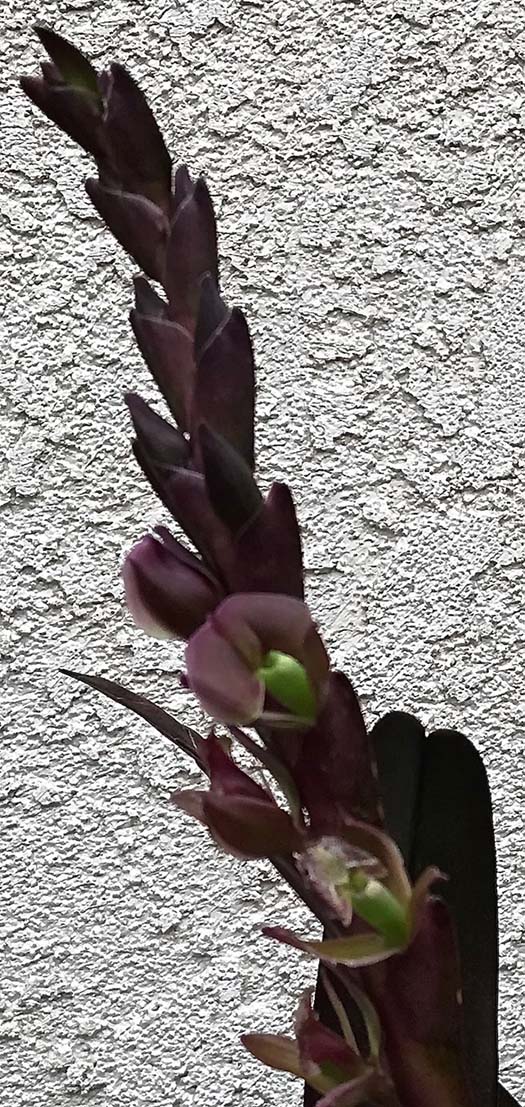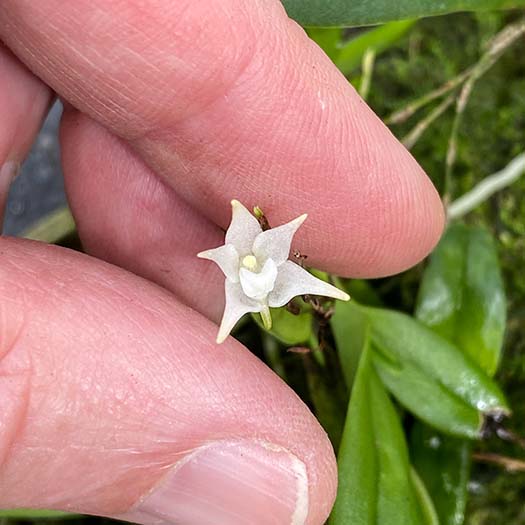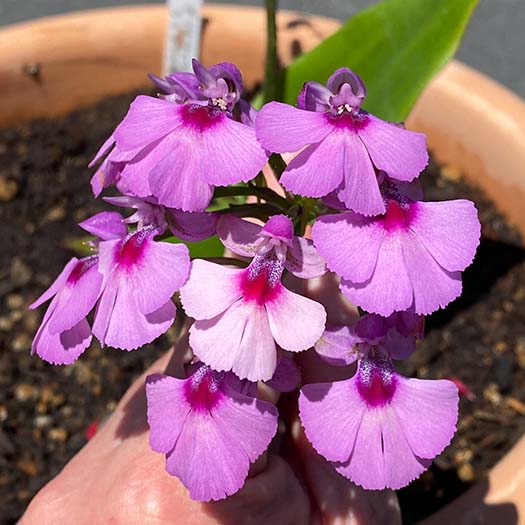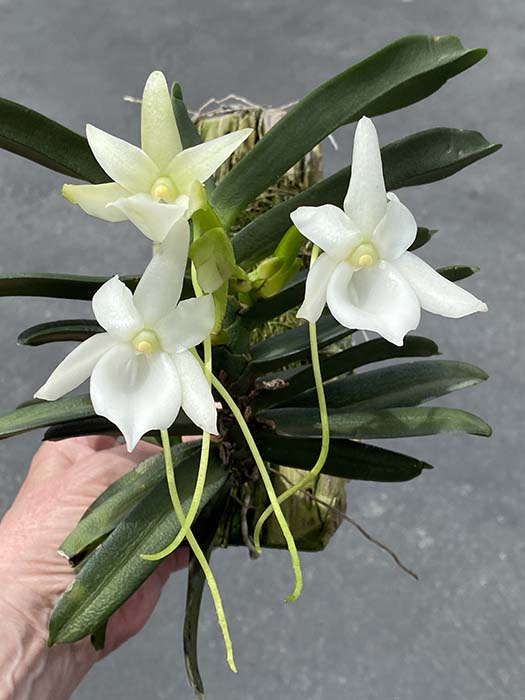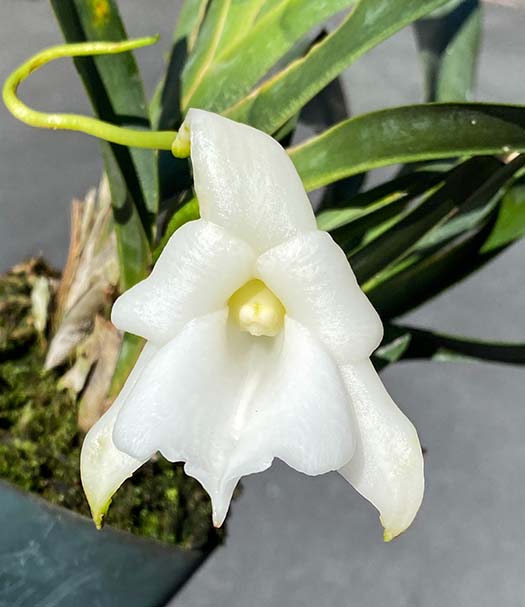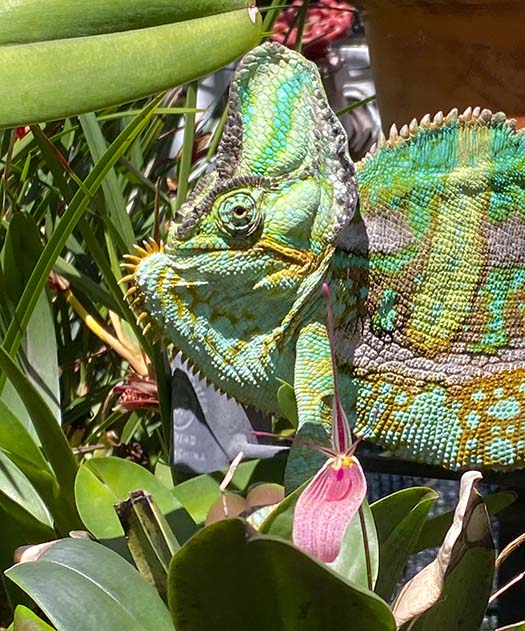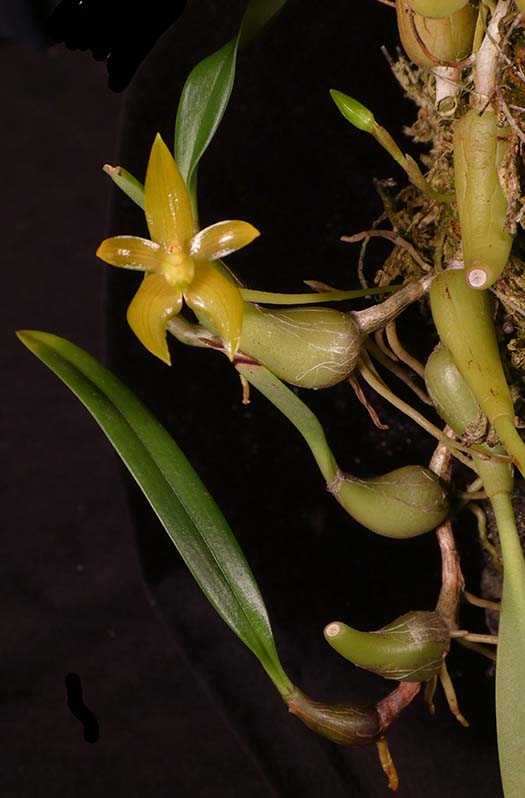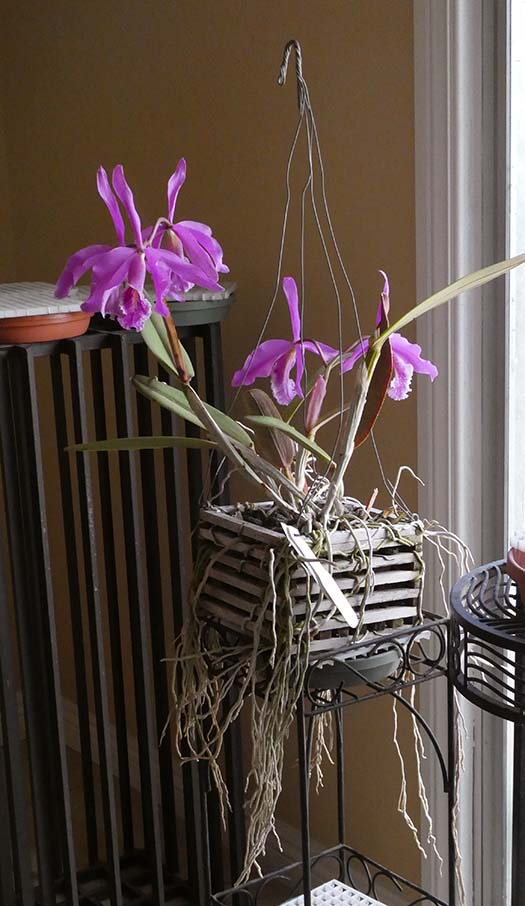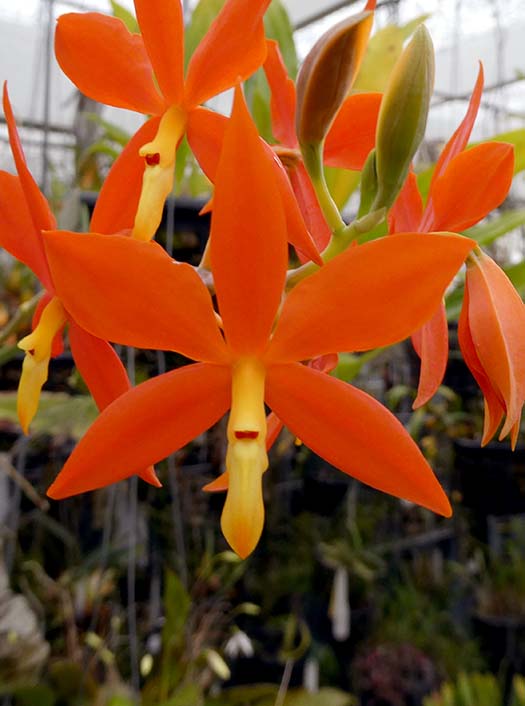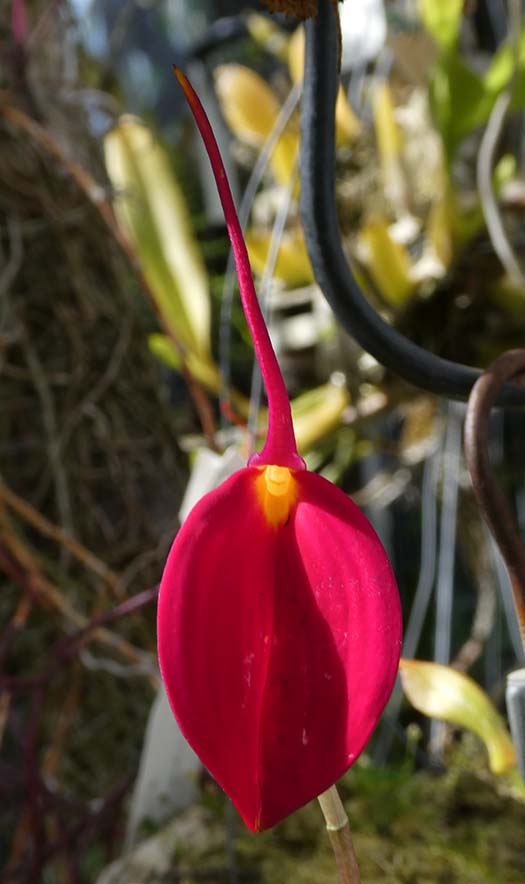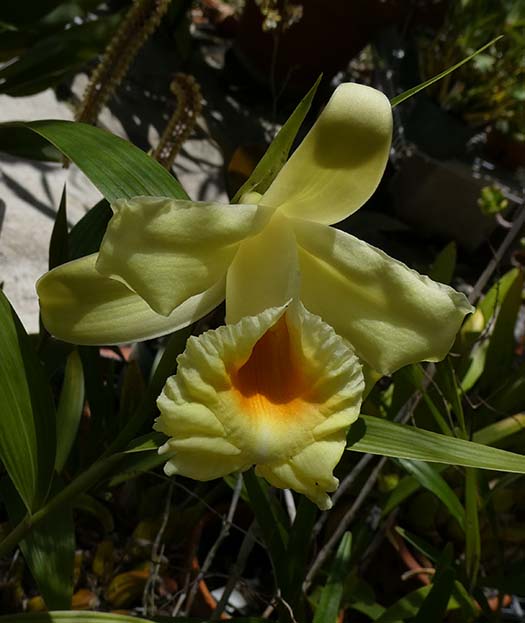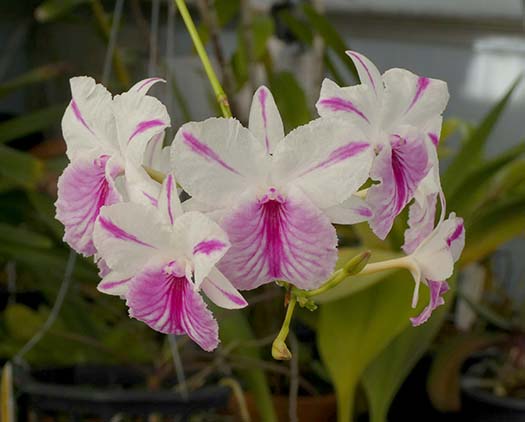July 2022
From Kurt Shanebeck:
|
|
Outdoors coastal, north of Los Angeles: |
|
Encyclia alataNative habitat is from Mexico and Central America below 1000m, seems to do reasonably well outdoors in coastal California. Growing potted in bark mix in bright light. |
|
Laelia purpurata v. carneaGrown potted in bark mix. Very large (>6”) flowers. |
|

Masdevallia niveaA Masdevallia from Colombia. Growing potted and shady. |
|

Stereochilus dalatensisA miniature from Vietnam with a Vanda type growth habit. Grown mounted in moderately bright light. |

Trichoglottis pusillaMiniature species from Java. Growing mounted with bright light. |
From Holly Hillman:All orchids grown outdoors, inland Orange County, CA |
|
Dendrobium lindleyi (aggregatum)It has bloomed before, this is the first time it has bloomed with two spikes. |
|
Prosthechea cochleataName means "Cockleshell" orchid but to me looks like a pod of octopi. |
|
From Lynn Wiand:All orchids grown outdoors, coastal southern California |
|
Dendrobium unicumFrom Thailand. This is a reliable bloomer, every year without fail. I love it because of its intense color. |
|
Epidendrum summerhayesiiFrom Costa Rica, Panama, Peru) Very difficult to photograph due to the intense burgundy-black color. It blooms off and on all year…blooming one flower at a time starting from the base of each spike as each flower dies the next one blooms. Stinky aroma. |
|
From Scott McGregor:All orchids grown outdoors, coastal southern California |
|
Cynorkis uncinataA tuberous African terrestrial—likes lots of light, water and fertilizer when in growth/bloom, and a dry rest when it is deciduous in the winter. |
|

Lycaste aromaticaDeciduous, and blooms with emerging new growth. Orange and intensely cinnamon scented! |
|
 |
 |
Elleanthus amethystinusThis Sobralia relative from the mountains of Peru and Columbia has small flowers in 1.5” clumps, but makes up for that with bright colors and lots of flowers. It is an easy outdoor grower and can handle some full sun. A 4’ ball of a plant grows in an 8” pot—they bloom better crowded, and are a hummingbird favorite. |
|

Cattleya (Laelia) purpurata v. schusterianaA reliable and showy species with contrasting white and dark purple. |
 |
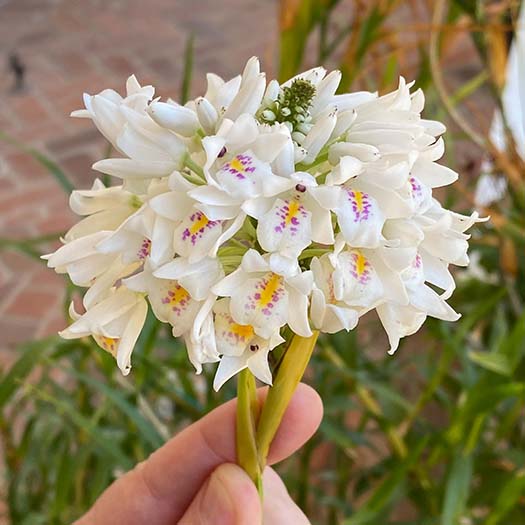
Neobenthamia gracilisA terrestrial from Tanzania, usually described as a “hot to warm grower”, but since it grows up to 2000 meters in elevation, does best outside here with sunlight and fresh air where it quickly grows into a 3’ bush with 5-6” “pompoms” of fragrant white flowers that have a splash of color on the top of every cane. The flowers open sequentially and so stays in bloom for many weeks. |
|
 |
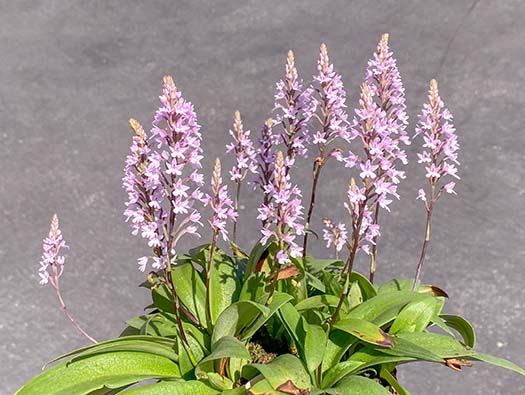
Stenoglottis macloughlinii (originally tagged woodii)An easy summer-blooming terrestrial, best allowed to grow into a clump since the individual flowers are small. |
 |
 |
Oncidium harrisonianumA reliable outdoor mini. Mine seems to have much more compact (crowded) flower spikes than the one Roberta showed last month. |
|

Renanthera pulchellaA pretty vandaceous species that blooms over many weeks. |
 |
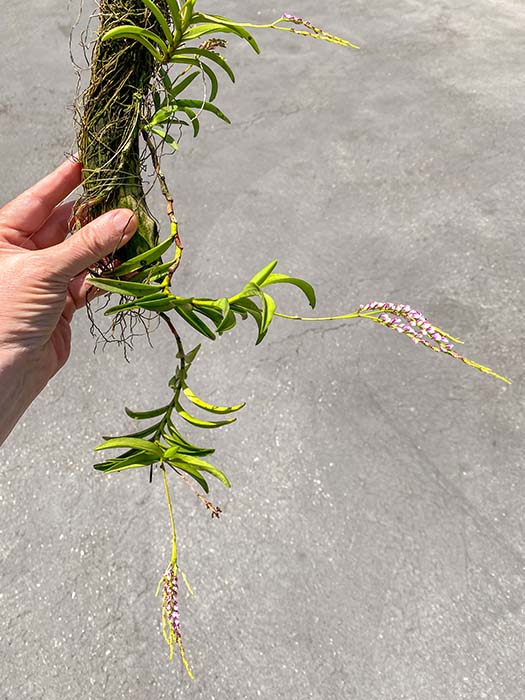 |
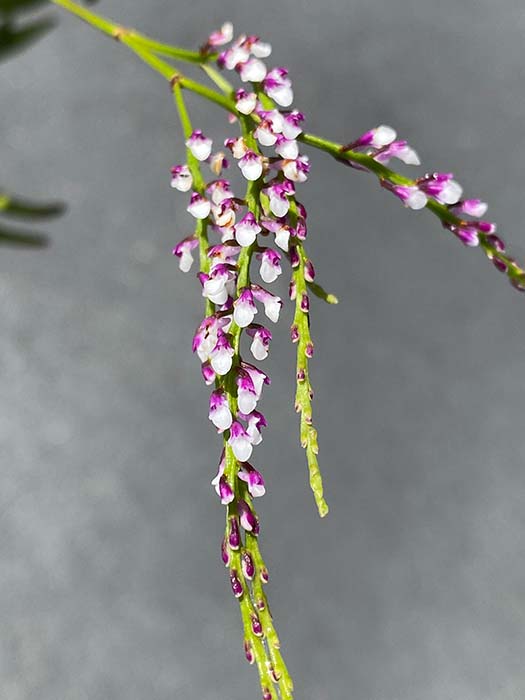 |
Schoenorchis gemmataMini vandaceous from Java, with pendant growth habit. Super-tiny flowers, but brightly colored and lots of them opening sequentially over several months. |
|
 |
 |
Schoenorchis juncifoliaAnother pendant vandaceous from Java—this one has the largest flowers of the genus, but still pretty small. A plant this size is in bloom almost all year with new spikes appearing every few weeks, and reminds me of Wisteria, making it a pretty desirable species despite the small flowers. |
|

Stereochilus dalatensisA cute Vandaceous mini from Vietnam. The column looks like a bird’s head. |
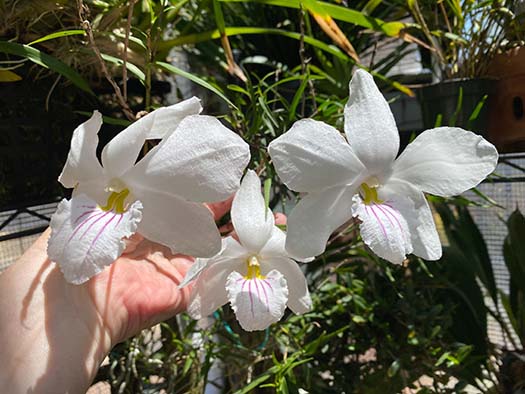
Dendrobium papilio (large form)A nice flush from the large form of this species, which normally produces only 1-2 flowers at a time. Blooms several times per year. |

Pleurothallis sarracenia (Acianthera bragae)An odd species named for the flowers’ resemblance to the carnivorous plant genus Sarracenia (pitcher plants). Some people liken the paired flowers to “kissing slugs”. Got a lot of them this year! |
 |
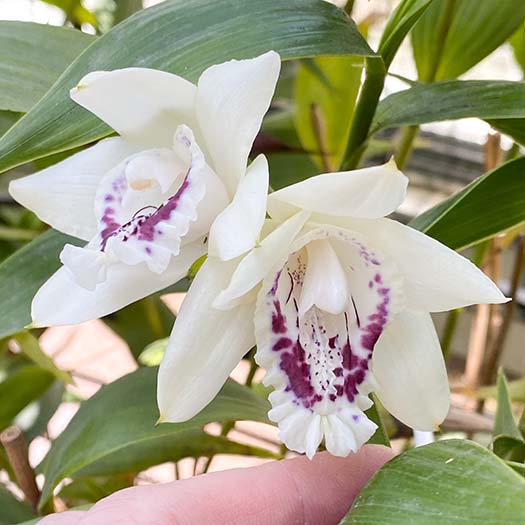 |
 |
Sobralia maduroiA great Sobralia from the highlands of Panama—stays compact, about 16” tall, and the flowers last for almost a week. Similar to S. undatocarinata, but why choose, grow both! |
|

Dendrobium trantuaniiA pretty Dendrobium species from Vietnam, small and compact plants, with waxy, long-lasting flowers. |

Meiracyllium trinasutumA cute creeping mini from Mexico with 1” flowers that smell strongly of cinnamon. |

Prosthechea cochleataOK, so the “clamshell orchid” isn’t the prettiest, but it is a very easy grower and with flowers opening sequentially over many months, it is almost always in bloom. |
 |
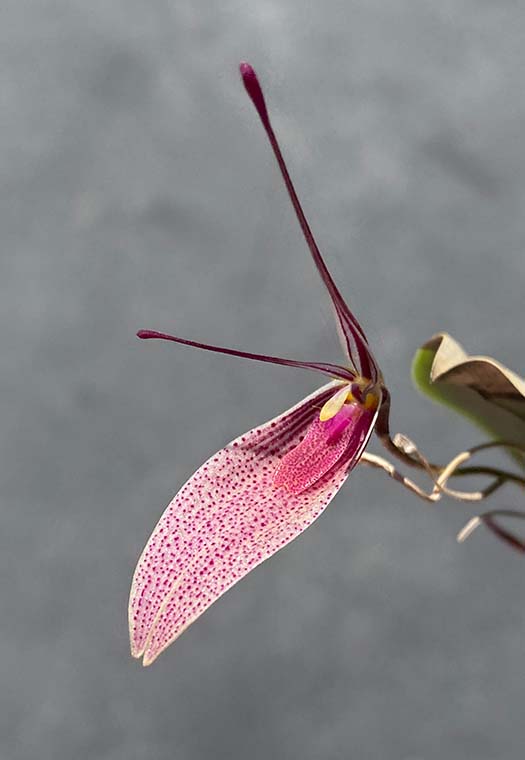 |
|
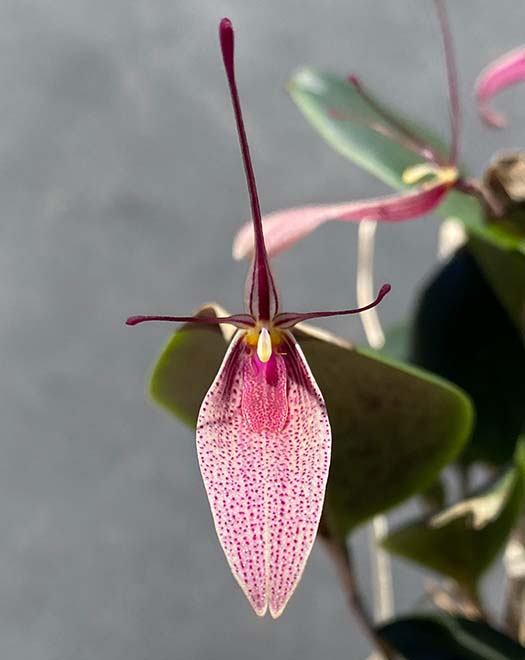 |
|
From Roberta Fox:
|
|
Outside in the Back Yard: |
|
 Bifrenaria inodoraNative to Brazil. Grown on the shady side - a difference from several other commonly-grown Bifrenaria species. The name implies no odor, but it does have a light fragrance during the warm part of the say. The flowers open green, become more yellow as they age, with striking contrast with the hot pink, hairy lip. |
|
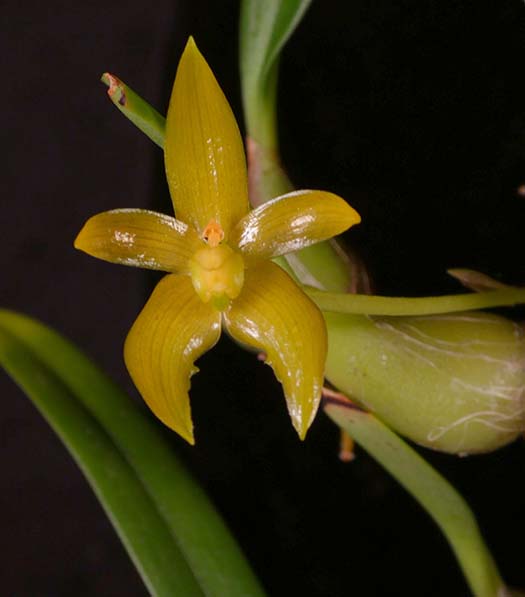
Bulbophyllum hamatipes
|
|

Cattleya maximaThis is the highland form, native to southern Ecuador and northern Peru at elevations of 1000- 2000 m. The plant and flowers are smaller than found on the warm-growing lowland form, but the color is more intense. I grow this hanging in filtered sun. The photo of the whole plant shows that it is a serious root machine, |
|
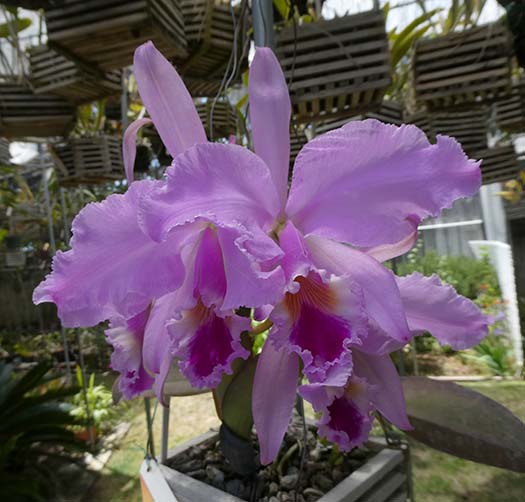
Cattleya warneriClosely related to C. labiata. Flowers are 7 inches or more across. It tolerates our cool winters - it gets some overhead protection from rain, but no other protection from the weather. |
 |
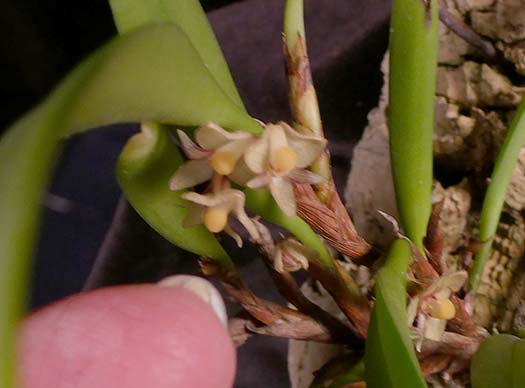
Ceratostyis himalaicaNot big and flashy, but cute. As the name implies, it is native to the Himalayas, in northern India, southeast Asia and south-central China. Flowers are about 1/4 inch. Leaves are succulent. |
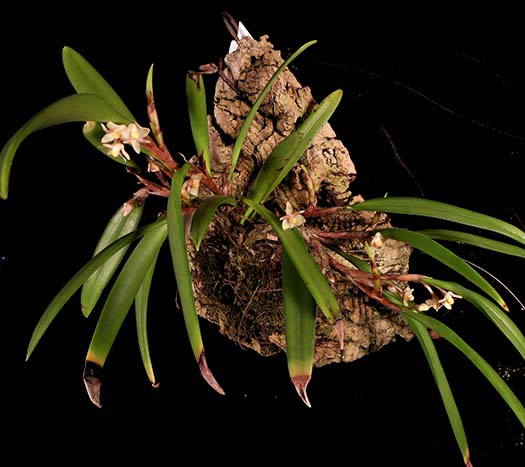 |
 Cuitlauzina pendulaI find this to be one of the most beautiful orchids, with the contrast of the soft pink petals and lip with the intense yellow throat. The flowers hang on an impossibly thin stem, so especially in the fading light of evening appear to float in space. That stem is, however, very brittle... I broke one once trying to "adjust" it, won't make that mistake again. (It looks flexible but it isn't) It is native to Mexico, at 1400-2200 m. Giving it a dry winter rest is said to induce blooming, but mine has bloomed wih no special treatment. The spike emerges from the newly-developing growth. |
 |

Dendrobium crepidatumAnother of my deciduous Himalayan Dendrobiums. It blooms on bare pseudobulbs just as the new growth starts to emerge. |
|
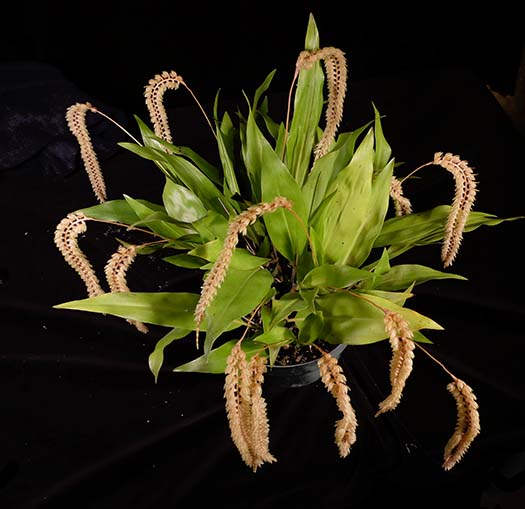 Dendrochilum glumaceumVigorous and floriferous. This species is native to a wide area of the Philippines at elevations up to 2300 m. |
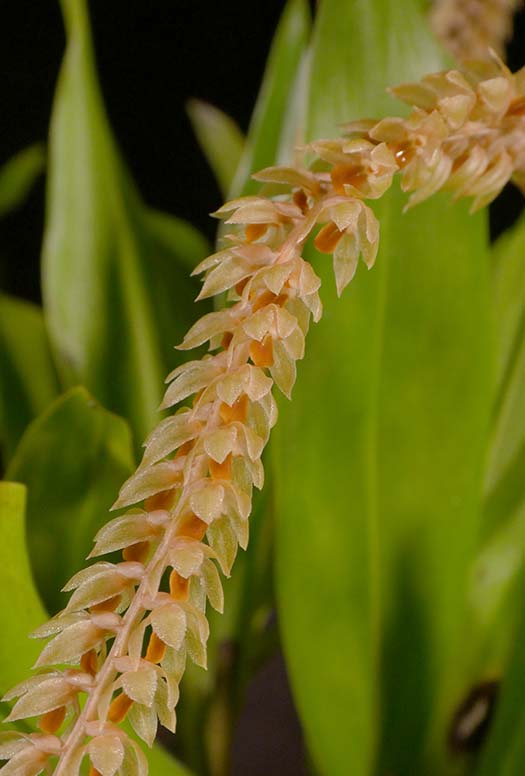 |

Dendrochilum pangasinanenseDelicate, lacy inflorescences. Flowers are fairly large for the genus. This species is native to the Philippines. IOSPE gives elevation of 600-900 m, which would indicate that is a warm grower. However, it does fine on my patio so I suspect that its range extends higher. |
 |

Diplocaulobium stelliferumThis plant produced a flush bloom at the beginning of June, then produced a smaller bloom toward the end of the month. Unlike some other member of the genus (such as Dcm. aratriferum) that have ephemeral blooms lasting less than a day, the flowers of this species last for 4 or 5 days. It has been classified as Dendrobium, but its behavior is quite different. |
 |
 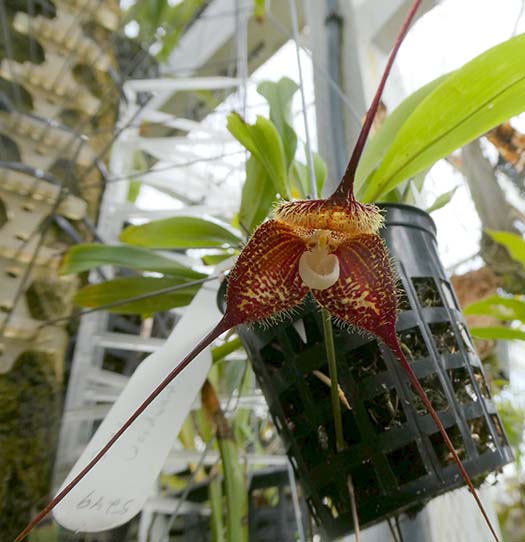
Dracula woolwardiiAnother reliable, repeat bloomer.The spikes tend to emerge from the bottom or side of the plant, so they need to be grown in baskets. They do need pure water. |
|
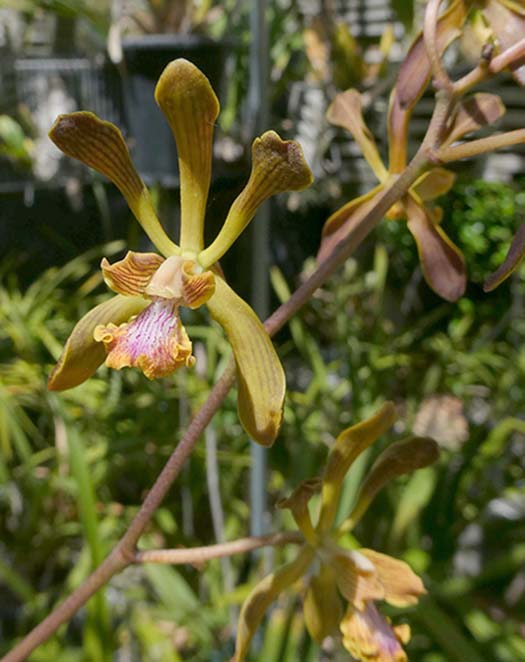 Encyclia belizensis ssp. parviflorumA very easy-growing Encyclia. This one is mounted but it can grow potted as well. |
 |
Prosthechea (Encyclia) vitellinaA dash of sunshine. This species is native to Mexico, Guatemala, and El Salvador, at elevations from 1400 - 2600 m. It grows in cloud forests, so heat is a problem. It grows well near the coast, but probably would not do as well farther inland. |
|
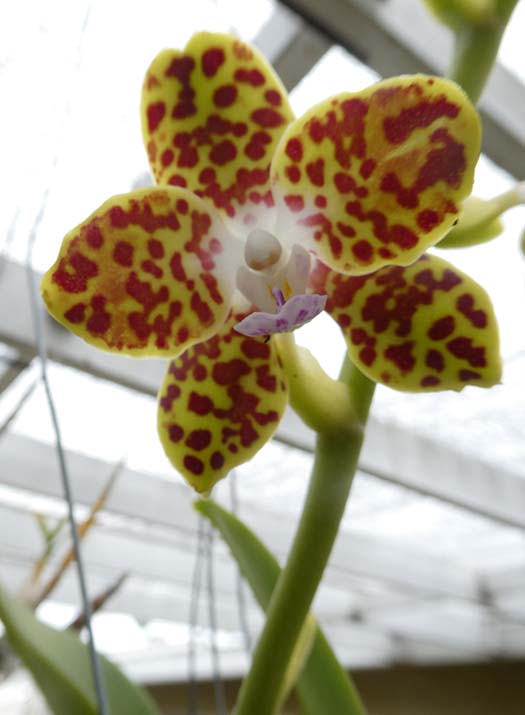 Phalaenopsis hygrochila (Hygrochilus parishii)And before that, it was Vandopsis parishii. Clearly this species has been a challenge for taxonomists. The plant looks like a Vanda and grows like a Vanda. It comes from a wide range of northern India and southeast Asia, at elevations from 600-1500 m, so it has no problem with our cool winter nights. There is a small amount of sphagnum at the bottom of the basket but all of the roots, big and thick, are outside. It has to grow hanging fairly high to accommodate them. The flowers are long-lasting and fragrant. |
 |
 Cattleya (Laelia) purpurataOne can't have too many L. purpuratas (I'm not changing my tags though they have been reclassified as Cattleya) , there are so many beautiful color forms. June and the beginning of July are the peak of blooming. Above is f. vinicolor, which has become a monster of a plant. Right is f. russelliana, with a lovely delicate pink lip. |
 |

Cattleya (Laelia) lobata f. albaA close relative to C. (L.) purpurata. Plant and flowers are a bit smaller, giving a better ratio of flower to plant. It still is not a mini... |
 |

Lockhartia oerstediiNote that even rather dead-looking growths can continue to produce flowers. When they are really dead they come loose naturally so I let nature tell me when they are done. Leaves look "braided". If divided, these propagate easily. |
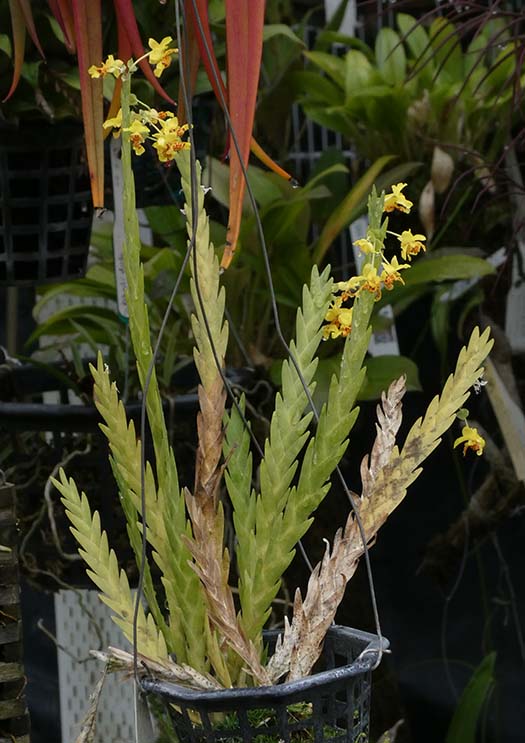 |

Lycaste consobrinaClosely related to Lycaste aromatica which Scott shows. This and several other similar species come from Central America. The plant produces many flowers from the base of old, bare pseudobulbs. New growth starts about the time the flowers are fading. It is sweetly fragrant. |
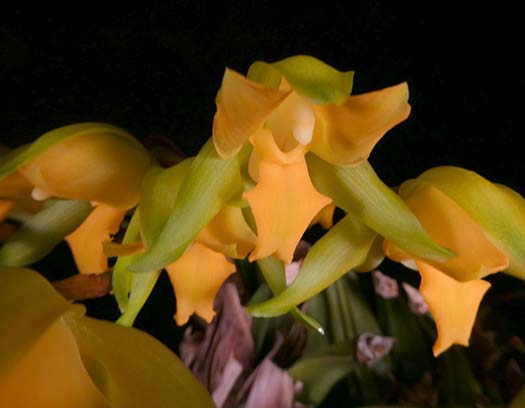 |
 Microcoelia stolziiA leafless orchid from eastern and central Africa, elevation 800-2400 m. The most important factor in culture is to give it plenty of water. The damp roots turn green, showing that they contain chlorophyll and can provide nutrition to the plant through photosynthesis. |
 |
 Miltonioides reichenheimiiNow classified as Oncidium. Flowers have heavy substance, and are shiny - almost look like plastic. |
|
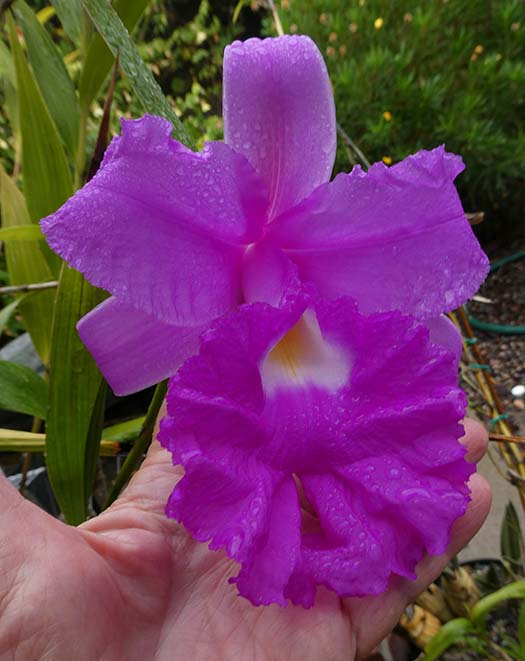
Sobralia macrantha (or rogersiana)Sobralias are starting to put on a show. This one was labeled Sob. macrantha, but it is much larger than my other macranthas. It may be rogersiana, but I would not be able to make a positive ID. All of these related plants produce short-lived flowers, but produce them sequentially over two months or so. |
|
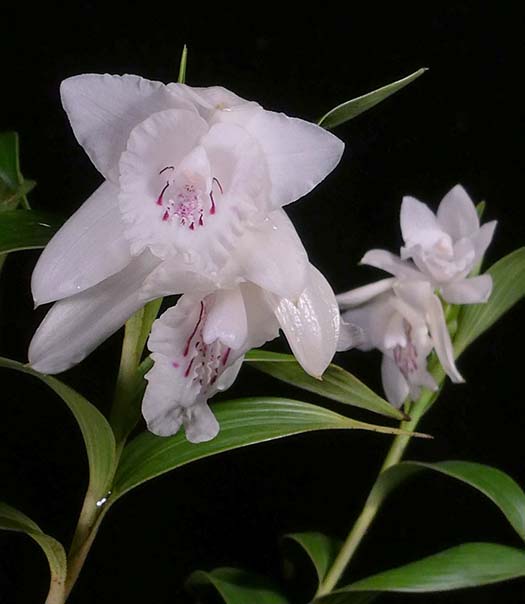
Sobralia undatocarinataThese flowers have heavy substance, and last much longer than those of most Sobralias, 3 or 4 days. The purple accent on the keels in the pristine white flowers give a dramatic touch. It's a relative small plant, a definite advantage in a crowed growing area. |

Sobralia macraScott and I each have a plant labeled 'Sob. macra' which is another, possibly undescribed, species. This one is truly Sob. macra. Unlike "not macra", it is a tall, rather leggy plant. The other one is more interesting. |

Zygostates allenianaThis is a miniature plant with miniature flowers. The leaves are about 3/8 inch (7-8 mm) and succulent, the inflorescences are a little less than an inch (about 2 cm), the flowers about 3/16 inch (5-6 mm) . But those flowers are beautiful and intricate, best appreciated in a closeup photo. |
 |
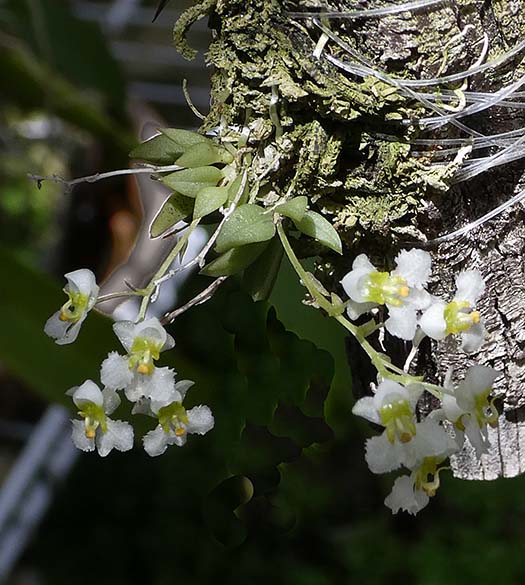 |
|

Zygostates lunataA bit larger than Zygostates alleniana. Leaves are soft, up t0 1 1/4 inch (4 cm), inflorescence 1 1/2 inch (4 cm), flowers a bit over 1/4 inch (7-8 mm) |
 |

Pleurothallis dilemmaThe leaf looks to me a bit like a string bean. It produces multiple flowers sequentially. |
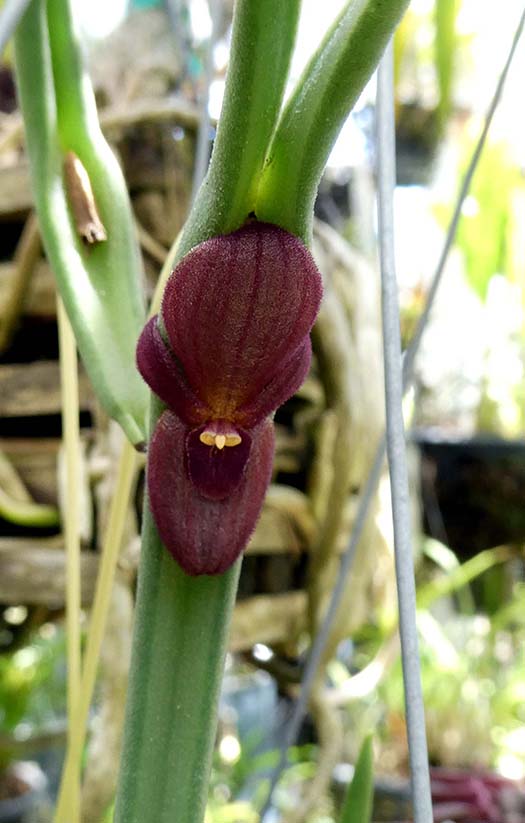 |

Pleurothallis viduataThis is in bloom most of the year, producing many flowers sequentially from each leaf. It had taken a little break, is starting on a new flush bloom, so it needed to show off. |
 |
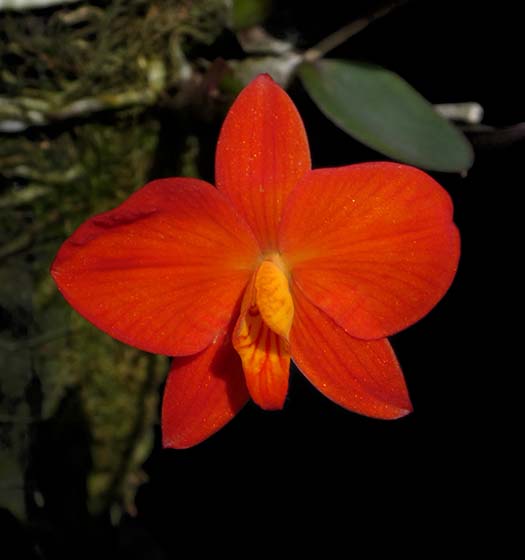
Sophronitis bicolor (Cattleya dichroma)Here is an example of what happened when Sophronitis got lumped into Cattleya... there already WAS a Cattleya bicolor (a big, beautiful bifoliate) so not only the genus, but the species got changed. The segments of this little gem sparkle like diamond dust in the sunshine - dffficult to capture in a photo. |
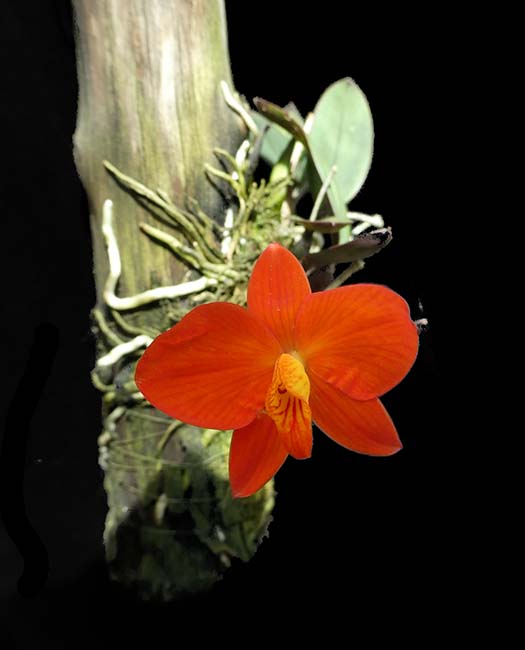 |
 |
 |
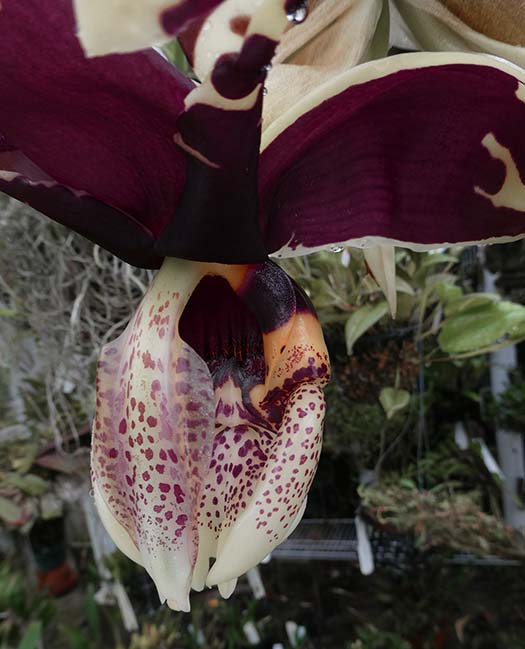 |
Stanhopea tigrina v. nigroviolacea 'Predator' FCC/AOS (Stanhopea tigrina)You just have to be there... Stanhopeas open with a sudden pop, releasing a burst of heady perfume. in a couple of days, it is done. (Last year I was on vacation for only a bit over a week, and missed the whole show, from several plants) For me, it has grown rather slowly. It is a piece of the awarded plant, but I don't see any sign that it will ever produce the number of spikes that it had when it was awarded, an amazing plant that I was fortunate enough to see. A challenge with Stanhopeas in general is keeping them wet enough. If they dry out even a little, they lose leaves and sulk. |

Barkeria melanocaulonFrom central highlands of Oaxaca, Mexico, elevations from 1400 - 200m. Barkerias go completely deciduous after bloomng. it's tempting to "clean up" the spent spike but don't! Much of that dead-looking spike is still green inside, and is the reserve for the plant for the next year's growth. Much of what looks dead certainly isn't. I wait until the following year, as the new leaves emerge, then the truly spent part is brittle and can be snapped off. |
 |
 |
|
In the greenhouse... |
|

Broughtonia sanguineaAn extremely vigorous small member of the Cattleya tribe. It has multiple color forms, from solid red to splash petal patterns like this, some with yellow rather than white backgrounds. |
|
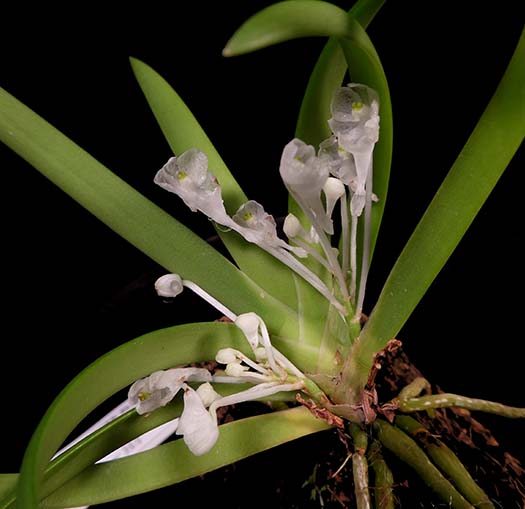 |
|
Podangis dactylocerasA small plant with a fan of succulent leaves and crystalline flowers. Native to western and central Africa. |
|

